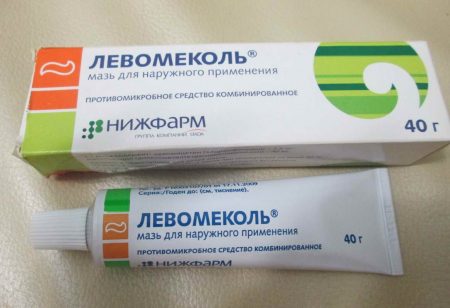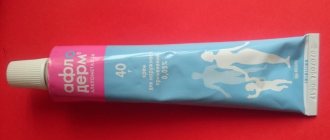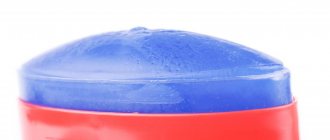Causes of the disease
The topical drug Levomekol is a combined broad-spectrum drug with antibacterial and regenerating effects. It is active against gram-positive and gram-negative bacteria, staphylococcus, Escherichia coli and Pseudomonas aeruginosa. Main components of the drug:
- chloramphenicol is an antibiotic that penetrates deep into tissues without violating the integrity of cell membranes;
- methyluracil - has regenerating and immunostimulating properties;
- polyethylene oxide - accelerates the absorption of the drug.
The medication is used to treat open and purulent wounds, trophic ulcers, bedsores, and long-term non-healing cracks. The ointment is used for rapid healing of abrasions, cuts, and insect bites. The antibacterial agent cleanses wounds of purulent contents, relieves inflammation and swelling. The ointment is used strictly externally, applied in a thin layer. A sterile bandage is applied on top and secured with a bandage.
Is it possible to use Levomekol ointment for allergies?
The drug is prescribed for the prevention and treatment of allergic dermatitis accompanied by a bacterial infection. The anti-inflammatory agent suppresses the negative manifestations of the allergic process. For allergies in areas of the skin, Levomekol effectively disinfects areas of scratching and ulceration, and restores damaged skin.
Can you be allergic to Levomekol ointment?
Usually the medication is well tolerated. In some cases, some people experience hypersensitivity to the drug, individual active ingredients or excipients. The pathological reaction is manifested by rashes on the skin at the site of application. Most often, allergies occur to the main active ingredient - chloramphenicol.
Reasons that provoke an allergic reaction:
- use with other drugs - pyrazole derivatives, sulfonamides, cytostatics;
- long-term use, the use of large quantities of the drug can cause desensitization of the body (the course of treatment should not exceed 5-10 days);
- pathologies for which the use of medication is not indicated - thrush, psoriasis, eczema, fungal diseases;
- simultaneous use of Levomekol with other ointments;
- violation of the storage conditions of the drug (the drug should be in a dark, cool place up to +15˚C);
- expired storage period.
People who are more often susceptible to allergic reactions: with a genetic predisposition, metabolic disorders, with physical and emotional exhaustion, suffering from chronic diseases and helminthiasis (see “Can parasites in the body cause allergies: the relationship between two diseases”).
An allergy to Levomekol in a small child can be most severe due to the imperfection of the baby’s immune system. Ointment is prescribed to newborns in exceptional cases: suppuration of the umbilical wound, multiple pustules on the body. For children aged 1-3 years - for furunculosis, fistulas, burns and frostbite.
Allergy to levomekol photo
Levomekol is a drug for the treatment of open wound surfaces, used only externally to reduce and eliminate foci of purulent and necrotic origin.
Compound
Levomekol is produced in the form of an ointment that has a complex antibacterial effect on the affected surfaces of the body.
The dense and viscous structure of the drug is given by the composition of the ointment, due to which it has a yellowish or beige tint and a specific mild odor.
At the same time, Levomekol acts only locally , practically not entering the bloodstream, which significantly reduces the risk of adverse reactions.
The main active ingredients of the drug Levomekol are:
- chloramphenicol , a drug with pronounced activity against pathogenic microflora (staphyllo- and streptococci, intestinal, pseudomonas, hemophilus influenzae, etc.), the ointment contains it in an amount of 7.5 mg;
- methyluracil , 40 mg, a drug with anabolic and anti-catabolic effects that actively regulates and accelerates tissue metabolism processes in the damaged area.
Thanks to the combination of these substances, the effect of cleansing the wound, healing it, reducing swelling, redness, pain is achieved, the local immune response is increased, and microbes are destroyed.
Additional substances in the medicine are polyethylene oxides , they help the ointment to be evenly distributed over the wound and facilitate the absorption of medicinal components.
Due to osmotic pressure indicators, the effect when applying the ointment to weeping and suppurating wound surfaces is not reduced; all therapeutic components are absorbed in a sufficient volume without dissolving in pathological fluids.
Since high osmotic activity persists for almost a day, the ointment does not require frequent use and is applied once a day.
What does Levomekol ointment help with?
Due to its effectiveness in combating suppurative processes, this drug is actively used in the treatment of open wounds in various branches of medicine.
Indications for the use of Levomekol ointment cover a whole range of dermatological, surgical, gynecological and other diseases.
Doctors can prescribe the drug for purulent processes after wound and traumatic injuries, for burns of thermal and chemical origin, to accelerate the healing of postoperative wounds, in order to cleanse and scar trophic ulcers, furunculosis, carbunculosis, abscesses, juvenile acne.
Instructions for use
The drug is intended for external use , it is applied to the skin or mucous membranes.
Cover the wound surface with a thin layer of ointment 1-2 times a day.
The standard course of treatment usually takes 5-7 days, depending on what the product is used for, the doctor can increase its period of use to 10-12 days. This treatment regimen is necessary for extensive and acute suppuration.
- For deep penetrating wounds, the ointment is heated and liquefied and applied to sterile swabs, which are placed in problem areas.
- When the wound passages are very narrow, thin tourniquets are used, and if it is impossible to insert it, the damage is filled through special rubber tubes or injection syringes (with the needle previously removed).
Levomekol is used in dentistry as part of complex therapy when patients have suppurative processes in the oral cavity.
The drug is actively used in the treatment of trophic ulcerative processes, pathological formations due to stomatitis, periodontal disease, cystic formations, as well as after implantation or extraction of teeth.
In gynecological practice and urology, Levomekol is applied to the area of suturing after surgical interventions complicated by inflammation or purulent pathologies in the external parts of the urethra or vagina. Levomekol in gynecology is prescribed for the treatment of cervical erosion, the development of infection in the ovaries, fallopian tubes, and vulva.
For men, the ointment is used for inflammation of the glans penis or prostate.
Otolaryngologists also use Levomekol in their practice.
In cases where the cause of the infection is a bacterial infection, the drug may be indicated for sinusitis, otitis, and rhinitis.
When treating sinusitis, the ointment is placed in the nose on the turundas, after first rinsing the nose with a sodium chloride solution. The procedure is carried out in a lying position, tilting your head back, it lasts 15-20 minutes. The course of therapy is 2-5 days; the ointment can be used no more than 4 times a day.
An ENT doctor will recommend how to use the ointment in the treatment of inflammatory diseases of the outer and middle ear:
This therapy is carried out for 5-10 days.
For acne
Levomekol is very actively prescribed for dermatological diseases, in the event of the development of purulent processes.
Therefore, the ointment is considered effective in the treatment of acne, furunculosis, and eczema.
For acne on the face, Levomekol is used pointwise, the ointment is applied to the top of the infiltrate, and when it breaks through, its internal space (cavity) is lubricated. Levomekol, used as an ointment for acne, can be a good help in the fight against teenage and young adult acne.
For hemorrhoids
The ointment is prescribed in case of complications with this disease, that is, with the development of purulent processes in the rectal area.
It is used to lubricate problem areas or use tampons treated with Levomekol.
For ulcerations from herpetic blisters
In these cases, the drug lubricates the opened infiltrates, so they are quickly cleared of pathological exudate and heal.
With suppuration of the lymph nodes
When diagnosing lymphadenitis in patients, Levomekol is used by applying ointment to the problem area under a bandage.
For wounds
Levomekol is actively prescribed in surgical practice.
To help open injuries heal faster, there are instructions for use on wounds. This guide details the rules and recommendations for the treatment of traumatic injuries with Levomekol.
The effect of the drug on the wound surface is due to its anti-inflammatory antimicrobial properties.
For burns
Levomekol is effective in treating burns that have become infected and have begun to fester.
In such cases, the ointment is applied to sterile gauze pads and applied to the affected area once a day.
Contraindications
Levomekol is considered a low-toxic drug, but when using the ointment, you should carefully study the instructions and follow all treatment recommendations.
Doctors avoid prescribing the drug for fungal infections, psoriasis and some other skin lesions.
An absolute contraindication is an allergic reaction to the main and additional components of this product.
Use during pregnancy
The ointment can be used during pregnancy and lactation.
The active components of Levomekol practically do not penetrate into the systemic bloodstream and therefore cannot harm either the mother or the child.
Of course, the ointment is used only after consultation with a doctor and if local irritation occurs, stop using the product.
Use in pediatrics
In accordance with the instructions, Levomekol ointment is used for children from the age of three, but in case of suppuration of wounds, doctors prescribe the drug for newborns and infants.
The product is used to treat the umbilical ring, abrasions, cuts, abscesses, bites.
Price in pharmacies
The medicine is produced in aluminum tubes weighing 40 grams.
You can buy it without a prescription; the cost of the ointment varies from 89 to 150 rubles .
Analogs
There are several drugs with identical composition on the pharmacological market.
Levosin and Levomekol , as well as Levomethyl and Voskopran are interchangeable medicines.
They are produced in the form of ointments, and Voskopran in the form of ready-made gauze napkins of various sizes.
They have one main antibiotic, but the composition of additional substances may differ slightly. Levosin, for example, has an analgesic component and other preservative components.
Which of these products to buy depends on the goals of treatment and the doctor’s recommendations.
Analogs of Levomekol in terms of action include Baneocin , Vishnevsky ointment , Solcoseryl , Streptonitol , Lingesin , Fastin and other drugs.
They have an antibacterial and (or) wound-healing effect, but at the expense of other active pharmacological substances. They are used as substitutes for Levomekol, mainly in cases of intolerance to chloramphenicol.
Storage rules
Since Levomekol changes its properties when heated, the shelf life indicated in the instructions (3.5 years) is relevant when the ointment is placed in a cool place, that is, in the refrigerator.
Reviews
Kozlova Maria, 34 years old, doctor:
Olga Shirokova, 44 years old, housewife:
The value for money here is simply amazing!
Konstantinova Anastasia, 24 years old, mother on maternity leave:
Which is better: Levomekol or Vishnevsky ointment?
Levomekol is an effective anti-inflammatory, antibacterial and wound healing agent based on powerful synthetic active ingredients.
The ointment is well absorbed without changing the structure of the epidermis, and retains its therapeutic effect for a long time.
Balsamic liniment according to Vishnevsky consists of natural substances (tar, castor oil, xeroform), it acts by creating a thin film on the skin, which does not allow microorganisms to develop and multiply.
The difference between the drugs is quite significant - Levomekol has a more active effect on pathogenic flora and has a wider spectrum of action against pathogenic microbes.
Oflomelid or Levomekol: which is better?
The difference between the drugs is that Oflomelid contains another antibiotic in its composition - ofloxacin and also a local anesthetic - lidocaine .
This composition ensures effective use not only in cases of development of a purulent process, but also in cases of severe pain on the wound surface.
This expands its scope of application in relation to large trophic, burn skin lesions and frostbite.
Levomekol ointment
Levomekol is an antibacterial combined agent for external use with a pronounced immunostimulating and anti-inflammatory effect. Levomekol ointment prevents pathogenic microflora from growing, suppresses inflammatory processes, removes purulent discharge and, at the same time, has a wound-healing effect and triggers regeneration processes of the epidermis.
Figure 1 – Levomekol for burns
A similar tandem is provided by two active components in the ointment - Chloramphenicol (aka Levomycetin) and Methyluracil. Chloramphenicol is a natural antibiotic that actively blocks intestinal, pseudomonas and staphylococcal bacilli. And methyluracil accelerates the regeneration of the epidermis.
The peculiarity of methyluracil is its ability to easily and quickly penetrate into the dermis, without affecting the membrane cell membrane. This process is associated with the removal of excess fluid from the intercellular space, which usually causes swelling and bruising.
What is Levomekol used for?
Levomekol has a multifaceted therapeutic effect:
- quickly reduces the inflammatory process, prevents its spread to healthy tissues;
- prevents the growth and reproduction of bacterial infectious agents;
- quickly eliminates swelling by normalizing microcirculation;
- ensures delivery of nutrients and biologically active substances, as well as molecular oxygen, to the affected tissues;
- stimulates the regeneration of inflammatory cells of all layers of the epidermis;
- increases immunity at the local level.
Figure 2 - Ointment quickly removes all inflammatory processes on the skin
It is worth noting that the presence of purulent discharge and necrotic tissue does not prevent Levomekol ointment from performing its function. The drug can be used to disinfect and accelerate tissue regeneration.
Indications for use of Levomekol ointment
Since Levomekol ointment has an antibacterial effect, and at the same time stimulates the restoration of tissue structure, the drug is indicated for the following diseases:
- infection of wounds with pathogenic microflora, ulcers and purulent abscesses on the epidermis;
- burns (mostly 2nd and 3rd degree);
- violation of tissue integrity due to injuries;
- necrotic processes;
- weeping and dry eczema;
- calluses;
- trophic ulcers;
- frostbite of the extremities (superficial layers of the skin);
- pimples, acne, carbuncles, boils;
- otitis and sinusitis (including with purulent discharge);
- treatment of sutures after surgery
- bedsores;
- haemorrhoids.
Source: https://zdorovo66.ru/allergiya-na-tele/allergiya-na-levomekol-foto
Symptoms
Signs of an allergic reaction to Levomekol in adults and children:
- skin rashes in the form of urticaria or vesicular rash;
- redness, appearance of erythema;
- burning, itching;
- slight swelling at the application site.
The general condition of the body usually does not suffer; in some cases, increased fatigue and weakness are observed. In rare cases, in people with a genetic predisposition to allergies and suffering from bronchial asthma, a symptom of an allergy to Levomekol may be angioedema .
Not all painful sensations when using the medicine are related to allergies. By disinfecting and cleaning the wound surface, the ointment can cause local reactions: tingling and itching caused by mechanical irritation of the wound and not of an allergic nature. They gradually weaken and disappear within 10-15 minutes.
A true allergic reaction has a more complex mechanism; the first symptoms appear 20-30 minutes after applying the ointment and gradually increase.
Diagnostics
The diagnosis is made by physically examining the patient and studying the medical history:
- a connection is revealed between the use of the drug and the occurrence of skin rashes;
- regression of symptoms is observed when treatment is discontinued;
- characteristic signs inherent in an allergy to Levomekol;
- episodes of hypersensitivity to ointment components in the past.
The possibility of replacing the drug with a hypoallergenic analogue makes in-depth diagnostics unnecessary. It is enough to consult with a doctor on how to quickly get rid of skin rashes, selecting an effective safe similar medicine and its dosage.
Treatment
If allergy symptoms appear, the affected area should be washed with running water and stop using the drug.
Drug therapy
Topical medications are the main treatment for allergies to Levomekol. Depending on the course of the disease, ointments are used:
- with a drying, relieving effect - Zinc ointment, Zinocap;
- healing, regenerating, restoring the epidermis - Bepanten, Solcoseryl, Panthenol;
- antipruritics - Fenistil, Gistan, Elokom;
- antibacterial (with antibiotic) destroy pathogenic bacteria that appear in scratching areas - Fucidin, Erythromycin ointment;
- hormonal drugs - Akriderm, Advantan, used for extensive rashes, used for a short time.
Children are prescribed Fenistil-gel for itching. Creams Bepanten, La-Cri, Skin-cap, Isis have a healing, regenerating effect. To accelerate the therapeutic effect, a short course of antihistamines is indicated: Suprastin, Diazolin, Tavegil, etc. Infants are given Fenistil drops, children from 6 months - Erius, Zyrtec (see “Antihistamines for children of different ages”).
Sorbents have a beneficial effect on the body in case of allergies: Enterosgel, Polysorb, Smecta accelerate the removal of excess histamine and serotonin from the body.
Analogues of the drug
What can replace Levomekol with allergies to continue treatment? List of antimicrobial agents that do not contain chloramphenicol, which most often causes an allergic reaction:
- Levomethyl - contains levomycetin, methyluracil;
- Protegentin - active substances - gentamicin sulfate, erythromycin, protease C;
- Streptonitol - contains sulfonamide, aminitrizole;
- Fastin - contains: anesthesin, furatsilin, syntomycin;
- Vishnevsky ointment - contains castor oil, tar, xeroform.

Medicines have antibacterial and anti-inflammatory effects, their effect is similar to the drug Levomekol.
Traditional medicine recommendations
During an exacerbation of the disease, you should adhere to an anti-allergenic diet: exclude citrus fruits, strawberries, eggs, chocolate, exotic fruits and nuts.
To relieve skin irritation, reduce itching and scratching, folk remedies are used:
- Baking soda is diluted in warm boiled water in a ratio of 1: 3, a moistened napkin is applied to the affected area for 10 minutes, then washed off with water.
- 1 tbsp. chamomile flowers are poured into a glass of boiling water, the infusion is used for lotions and compresses. The solution is taken orally, 1 tbsp. l. 3 times a day.
- Children benefit greatly from baths using medicinal herbs: string, chamomile, calendula.
- Compresses made from peeled, grated potatoes, applied for 30 minutes, effectively relieve irritation.
- Foci of inflammation are wiped with green tea bags soaked in water.
- Tea with grated ginger root accelerates the removal of toxins from the body (see “How to cleanse the body of allergens and toxins for allergies?”).
Persons prone to allergies should eat foods containing natural antihistamines: seaweed, buckwheat, rosehip tea. A healthy lifestyle, hardening, living in an area with good ecology serve as the prevention of allergic reactions.
Being a relatively safe and effective remedy, Levomekol ointment can cause allergies. It is important to be aware of the possible side effects of the drug; when the first symptoms appear, immediately stop therapy so as not to worsen the situation. Particular care should be taken when treating young children, pregnant and lactating women, and the elderly.
Description of the drug
Levomekol is a means of external use in the form of an ointment. It is used to treat bacterial skin infections.
Advice! The course of dermatitis of any nature is often complicated by the addition of a bacterial infection, since scratches, cracks and other skin lesions serve as “entry gates” for bacteria.
The drug contains substances that have a detrimental effect on bacteria, these are:

- Chloramphenicol;
- Methyluracil;
- Polyethylene oxides.
These components are active, they have the main therapeutic effect, and the remaining components are auxiliary. They are used to give the composition the necessary consistency, as well as to ensure better penetration of the active ingredients to the site of inflammation.
The product is white with a yellowish tint. The texture is homogeneous without impurities. The product is easily absorbed without leaving stains on clothes.
The use of Levomekol is advisable if the main cause of the disease is the presence of a bacterial infection. Therefore, this remedy is used if there are signs of suppuration. The use of the drug allows you to cleanse the epidermis of necrotic masses and promotes faster healing.
Most often, this remedy is recommended in cases where the course of a skin disease is complicated by a bacterial infection. The ointment can be prescribed in the treatment of the following types of dermatitis:

- atopic;
- allergic;
- bacterial.
Advice! The use of antibacterial ointments can be prescribed not only when signs of infection appear, but also for prevention. For example, for atopic dermatitis in children, the use of Levomekol avoids infection.







